Journal of Environmental Protection
Vol.4 No.11(2013), Article ID:40195,7 pages DOI:10.4236/jep.2013.411146
State of Air Quality in Malawi
![]()
1School of Environmental Studies, China University of Geosciences (Wuhan), Wuhan, China; 2Department of Physics and Biochemical Sciences, The Polytechnic, University of Malawi, Private Bag 303, Blantyre, Malawi.
Email: *xianjun.xie@gmail.com
Copyright © 2013 Harold Wilson Tumwitike Mapoma, Xianjun Xie. This is an open access article distributed under the Creative Commons Attribution License, which permits unrestricted use, distribution, and reproduction in any medium, provided the original work is properly cited.
Received July 6th, 2013; revised August 8th, 2013; accepted September 5th, 2013
Keywords: Air Quality; State of Environment Report; Ozone Depleting Substances; Climate Change; Malawi
ABSTRACT
Air pollution in Malawi is recognized as one of the key environmental issues. Out of nine key issues it is ranked eighth on priority issues. This has led to lagging behind in terms of research and reporting on the issue. However, the Malawi Government has made strides in implementing policies, acts and programs that are directly or indirectly concerned with the improvement and abatement of air quality to meet the millennium development goals (MDGs) especially goal number 7. The inventories and studies show that air quality in Malawi is still good, but future anticipated air quality problems are cause for worry such as impact on human health, global climate change and ozone depletion. Trends in consumption of ozone depleting substances (ODS) show a remarkable drive towards total reduction. Emissions standards are in place in line with World Health Organization (WHO) guidelines. Recommendations on how to deal with air quality issues have been proposed in the national state of environmental report (NSOER) in that: 1) there is a need for an operational framework for climate change programs in Malawi and; 2) there is a need to unify climate change policies dealing with enforcement of ODS phasing out, alternative energy sources, emissions from vehicles and industries, and institutional and human resource capacity.
1. Introduction
Air pollution is one of the environmental problems that scientists, policy makers and citizens are concerned about. In modern society, air quality has been a focus and various studies have been done on the implication of polluted air on human health and ecosystem integrity [1,2]. Much of the studies are done in urban areas to assess the quality of air due to urbanization and population growth accompanied with increased domestic and vehicular fuel use as well as industrial growth [3-8]. Effects of air pollution on human health have been done and reviewed [9-11]. A distinction between indoor and outdoor air quality is made when reporting in order not to confuse the outcomes of the results. Taeja et al. [12] suggested that outdoor concentrations of air pollutants could estimate indoor pollution for some pollutants such as nitrogen dioxide (NO2), sulfur dioxide (SO2) chlorine gas (Cl2) and carbon dioxide (CO2). However, they also hinted that indoor air pollution may be poorer than outdoor due to various factors especially sources of pollutants and dispersive effect of wind.
Malawi is a country in southern Africa within the Southern Africa Development Community (SADC) grouping (Figure 1) with a population of 14.9 million (with approximately 85% living in rural areas). As a nation, Malawi has made strides towards achieving a sustainable air quality to ensure a sustainable environment for the survival of its citizens and economic development. This is articulated in the drive towards achieving Millennium Development Goal number 7 and the current indicators of attaining the same [13].
In order to achieve a better environment, the Malawian Government embarked on producing and adhering to an environmental plan after Rio Conference 1992’s Agenda 21. This plan was adopted in 1994 as the National Environmental Action Plan (NEAP) adopted in 1994. Within the framework of NEAP, the state identified 9 key environmental issues to focus on and ranked them according to severity. Of these issues, air pollution is ranked eighth followed by climate change. Air Pollution and Climate
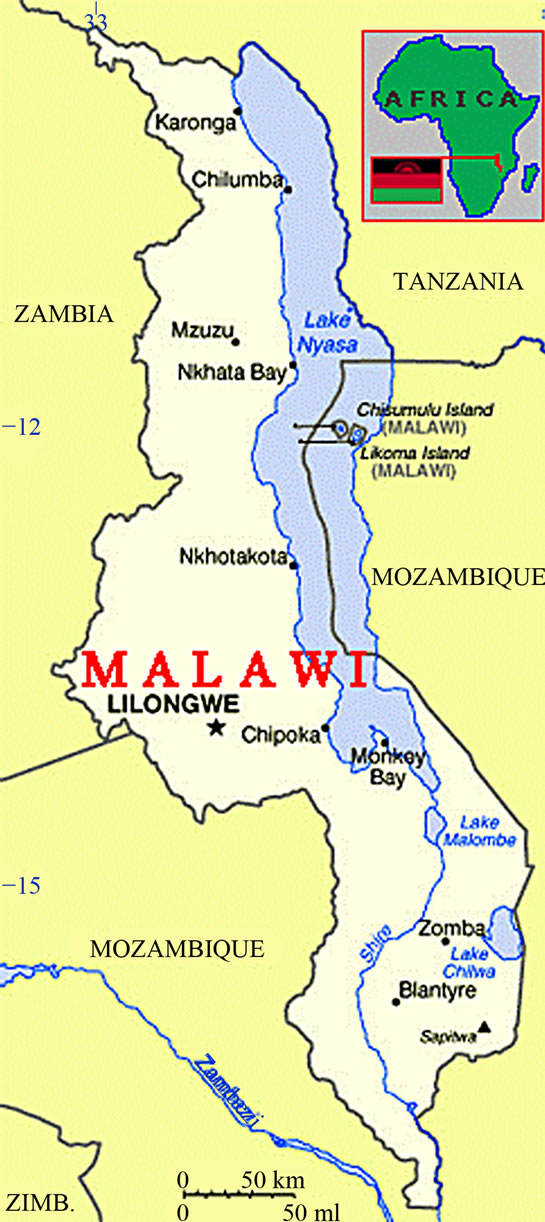
Figure 1. Map of Malawi and its neighboring countries (www.theodora.com/maps).
changes are directly linked aspects as such one cannot discuss air pollution without alluding to climate change. In the subsequent years, the Malawian Government produced the National Environmental Policy (NEP) adopted in 1996 and Environmental Management Act enacted in 1997. In 2004 the Malawi Government revised NEP with changes to suit current strategies to combat environmental problems and achieve MDGs.
Besides, the national state of environmental report (NSOER) [14] provides an indication of how the environment is fairing in terms of the 9 key environmental issues that include air quality. Currently, it is reported that air quality is still fairly good. However, especially since air pollution is ranked almost the least of the 9 key environmental issues, much work and monitoring has been lacking. Despite that, there have been some strides made about air quality in Malawi. As such this paper is explaining the current state of air quality in Malawi since Rio 1992 and the implications of industrial development on one side and choices of energy sources on the other.
2. Methodology
A desk review of government reports and documents, policies and laws, journal and internet articles, was carried out. Key documents reviewed include: National State of Environment Report of 2002, An Inventory of Ozone Depleting Substances in Malawi for the Period 2002 to 2003, Draft Second National Communication of Malawi of 2009, an Inventory of Ozone Depleting Substances in Malawi for 2009, National State of Environment Report of 2011 and Southern Africa Policy Dialogue on Air Pollution of 2008.
3. Results
3.1. State of Air Pollution in Malawi
According to studies by Dasgupta et al. [15], in a sample ranking of 31 countries it showed that Malawi’s rank on income and environmental indices in terms of air is 18. In this study, industrialized countries and least developed nations were studied, Malawi’s focus on air quality compared to its neighbors was better. Zambia was ranked 22 while Mozambique and Tanzania were ranked 27th and 29th respectively.
Approximately 1.4% of total mortality, 0.5% of all disability-adjusted life (DALYs) and 2% of all pulmonary diseases [16,17] are attributable to outdoor pollution.
Lack of monitoring equipment and systems hinder studies in air quality in Malawi. Very few places have monitoring systems in Malawi. The Lilongwe International Airport has one monitoring system for air quality. The Polytechnic, University of Malawi has another monitoring system. However it has limited sensors available for SO2, NO2 and Carbon Monoxide (CO) besides wind speed and temperature. As such it is not easy to extrapolate results over the whole country. Indoor studies have been carried out but on a very limited scale and much localized studies in recent years [18,19].
Air pollution is not routinely done in Malawi. However, greenhouse gas inventories have been carried out at national level using 1990 and 1994 as baseline [14]. Air pollution occurs countrywide in Malawi. Composition of air in all areas is a combination of dust, gases and car exhaust fumes that affects the air quality in both urban and rural settings. The use of large diesel vehicles especially in the transport sector which are poorly maintained make a significant contribution to poor air quality in urban areas. The large volumes of vehicles in cities [8] and the increased incidences of traffic congestions in the highways contribute significant amounts of carbon monoxide, carbon dioxide, volatile organic compounds and secondary pollutants to the poor quality of air.
Poor planning of cities may also be an issue contributing to the severity of air pollution especially in the wake of high numbers of car ownership. Smoke and haze especially in the rural areas are other pollutants experienced in Malawi due to bush fires, burning of tires, biomass burning and dust.
3.2. Studies and Reports on Air Quality in Malawi
As of 2002 [14], two greenhouse gas emissions assessments were completed in 1997 and 2002. This is done in accordance with the requirements of United Nations Framework Convention on Climate Change (UNFCCC) (Kyoto Convention). Malawi signed this convention in 1992. Due to land use pressure and growing industrial activities, Malawi’s trend on emissions is relatively increasing.
Inventory on green house gases (GHG) show that Malawi is a net emitter. This simply implies that the total emission levels exceed the sink capacity [20,21]. The major sources of GHG are energy (combustion of fossil fuels and fugitive emissions), industrial processes and other products (mineral processes and solvents), agriculture forestry and other land use (AFOLU) (Livestock, land use and non-CO2 emissions) and wastes (solid waste disposal, incineration/open burning and waste water treatment) (Figure 2). According to National State of Environment Report [22], Malawi emits on average about 22708 Gigagrams (Gg) of CO2 equivalents. 95% of this is traced to AFOLU.
The same sources of GHGs are responsible for emissions of CO2, SO2, nitrogen oxides (NOx), non-methane volatile compounds (NMVOCs) and PM [23]. Figure 3 illustrates the percentage contribution of air pollutants to total emissions for Malawi as at 2000.
No comprehensive studies have been carried out on particulate matter (PM) in Malawi. However, segregated studies have been carried out [25-27].
The cutting down of forests for firewood due to lack of access to electricity [28] is reducing the purification capacity of vegetation for pollutants such as CO2. This se-
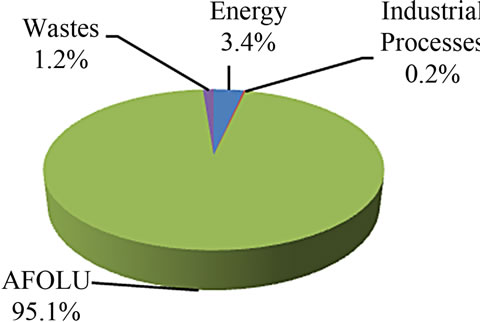
Figure 2. Sectoral GHG emissions [23].
questration challenge is allowing CO2 to fugitively accumulate in the atmosphere and thus increasing the likely hazard to human health and threatening the ecosystem integrity. The trend in CO2 emission for Malawi is rising as depicted by the results in Figure 4.
The reduction strategies for ozone depleting substances in Malawi have been enforced by Environmental Affairs Department during the 1998/99-1999/2000 reporting period [14]. Substances such as Chlorofluorocarbon (CFC) family of gases that are used for various purposes such as propellants, as refrigerant gases in home refrigerators and car air conditioners, cleaning of electronic components and countless other applications have been banned. Citizens have been sensitized on the dangers of using such products.
Following the Montreal protocol, Malawi has committed itself to phasing out completely Methyl Bromide. It is anticipated that importation of Methyl Bromide will decrease if the phasing out program is strictly followed. But as at 2002 [14], the figures did not register any positive strides in the reduction of Methyl Bromide.
Periodic inventory on ozone depleting substances (ODS) has been done on both production and consumption [21, 29,30]. Current UN Data indicate a sharp reduction of ODS consumption in Malawi (Figure 5) despite an indication of a little rise in 2007. Impacts of ODS on human and ecosystem health in Malawi haven’t been studied fully. Besides depleting ozone, the IPCC report show that ODS contributes towards global warming with a substantially higher global warming potential (GWP) [31].
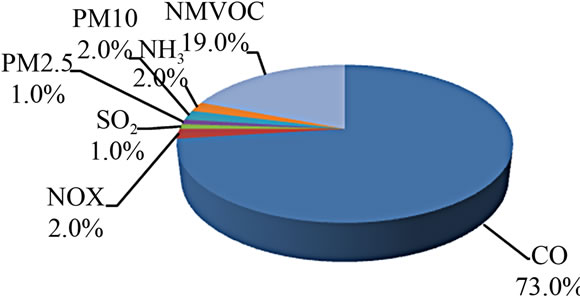
Figure 3. Contributions of air pollutants to total emission for Malawi 2000 [24].
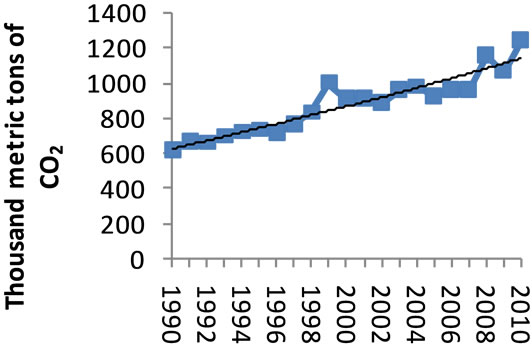
Figure 4. Carbon dioxide emissions for Malawi in the period 1990-2010 [13].
3.3. Policies and Legislation Related to Air Quality in Malawi
There is no relevant climate and air quality Act in Malawi. However various legal instruments such as the Environmental Management Act, National Environmental Policy (revised), Malawi Energy Policy and other sectoral acts dedicate sections that discuss the significance of considering air pollution in all activities. Thus protection of air quality is given a part in many acts available in Malawi. The sectoral environmental impact assessments (Mining, Irrigation, Sanitation and Waste Management) guidelines that stem from EIA guidelines adopted in 1997 stress on the significance of incorporating air qual-
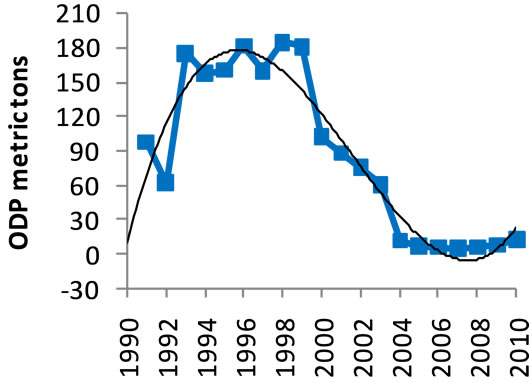
Figure 5. Consumption of ODS in Malawi (Data retrieved on 20-05-2013 from UN Statistics Division [32].
ity when conducting EIAs. The Millennium Development Goals (MDGs) for Malawi, Vision 2020 and Malawi Growth and Development Strategy (MGDS) stress on air quality for the better environment for all Malawian citizens and sustainable development of the nation.
3.4. Air Quality Standards
The air quality standards in use at the moment are based on the WHO air quality standards for air pollutants. In line with WHO guidelines, the Malawi Government through Malawi Bureau of Standards published in 2005 Malawi Standard MS 737:2005 “Industrial emissionsEmissions from mobile and stationary sources-Specifications”. The guidelines specify maximum allowable limits for gaseous and particulate pollutants [33] (Table 1). The guideline also proposes mechanisms to reduce emissions from stationary and mobiles sources. They prescribe types of mitigation measures and best available techniques (BATs) that can be used especially in industrial emissions scenarios. Besides air quality standards limits, the guidelines stipulates the emissions limits for gaseous and other air pollutants (well elaborated in MS 737:2005). Most significant is the special guidelines on particulate matter emissions limits and air quality standard limits for motor vehicles. Tables 2 and 3 highlight the specifications for emission limits for selected industrial activities.
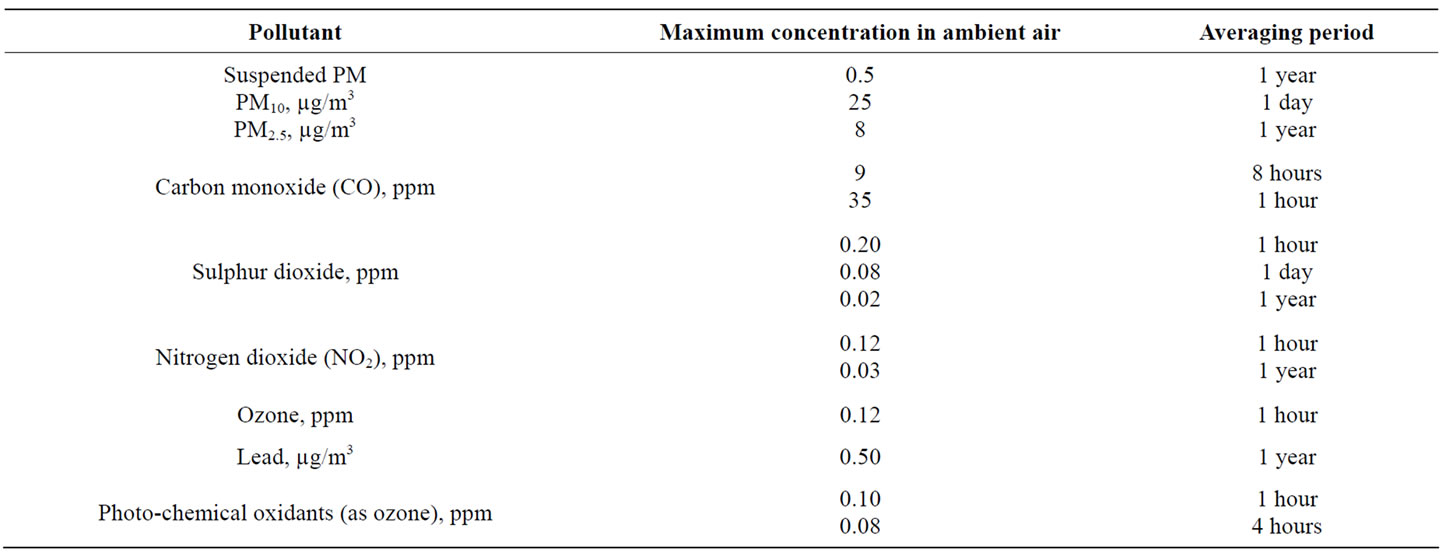
Table 1. Ambient air quality standards limits for Malawi [33].

Table 2. Air quality standards for motor vehicles in Malawi [33].
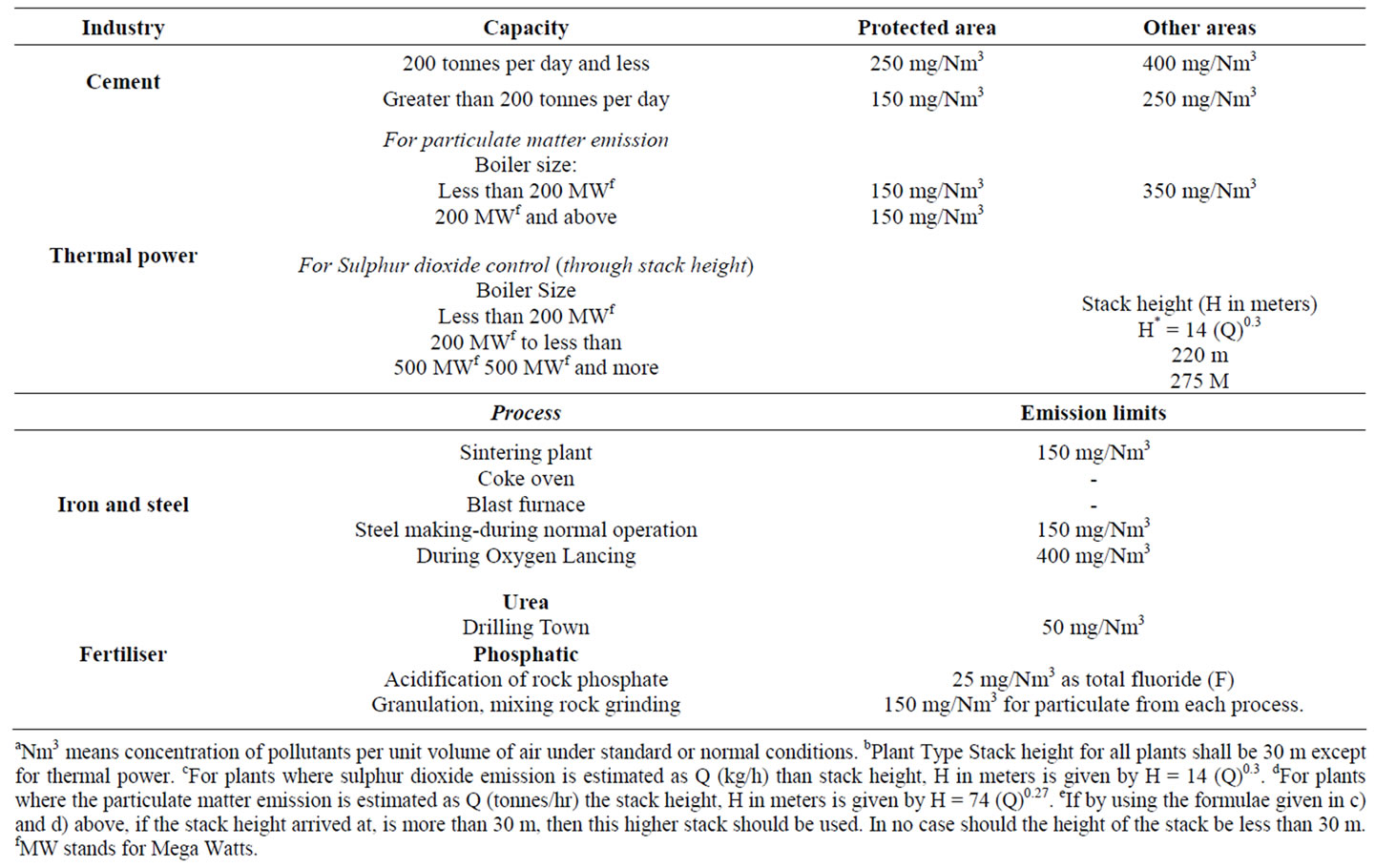
Table 3. Standards for particulate matter for selected industries in Malawi [33].
4. Discussion
According to preceding sections, Malawi’s air quality is still not alarming. However, urbanization, population growth, increasing number of vehicles and booming industrial activity, very soon the current status (as at 2002), will be surpassed and health implications of poor air quality will be a significant contribution to hospital cases. Various, however limited, studies show that urban and rural settings have some sort of air pollution localized due to various activities such as tire burning, biomass burning, firewood use and charcoal utilization. The study done by Fullerton et al. indicates that biomass fuel in Malawi is a significant contributor to human health problems associated with air pollution [18]. It was observed that indoor air pollution in Malawian homes is high due to biomass fuel usage [18].
Another study done in 2010 in Blantyre City’s major highway and industrial locations implicate vehicular and industrial activities to the poor quality of air due to NMVOCs and CO levels [8], although the amounts were not that alarming as CO levels were below the ambient air quality standard limits. The use of wood fuel in rural homes contributes to significantly higher particulate matter (PM) while in urban setting CO2 is significantly higher due to use of charcoal as fuel. Figure 4 has shown that as at 2010, the amount of CO2 emission in Malawi is on the rise and maybe projected to continue increasing. This is surely having a bearing on the attainment of MDG number 7. As such, alternative energy access and utilization would reduce such contributions. In major highways, expansion of transport roadways can reduce air emissions from vehicles as is periodic maintenance of vehicles.
Various initiatives, strategies, policies and programs [22] have been put in place in response to air pollution, climate change and ozone depleting substances. Diverse social and economic factors have been and will still continue to play key roles in enhancing and/or derailing the progress to a better air quality in Malawi.
GoM [22] stipulates various recommendations and grouped them as: 1) there is a need for an operational framework for climate change programs in Malawi; and; 2) there is a need to unify climate change policies dealing with enforcement of ODS phasing out, alternative energy sources, emissions from vehicles and industries and institutional and human resource capacity.
5. Conclusion
Air quality in Malawi is still not alarming; however there is a need to install monitoring systems to check for trends in air pollution. Policies and legal instruments dealing with air pollution in part are in place and enforcement is what is needed. Adhering to protocols and conventions signed by the Government can reduce gaseous emissions in the country. Research on air quality is lacking in Malawi due to lack of measuring instruments which require investments and commitment from Government. Industrial activities should be monitored for emissions and abatement of such be prescribed for each industry.
Various initiatives, strategies, policies and programs have been put in place in response to air pollution, climate change and ozone depleting substances while recognizing that social and economic factors will continue to play significant roles in achieving a better air quality in Malawi. NSOER stipulates various recommendations to be followed closely in order to achieve this.
6. Acknowledgements
We greatly appreciate the effort made by Malawi Government for making the reports and documents available for academic purposes especially through the Department of Environmental Affairs and Malawi Bureau of Standards. We are thankful to University of Malawi for the support. We extend our heartfelt gratefulness to China Scholarship Council for making this work possible. We highly value the input of the anonymous reviewers.
REFERENCES
- A. N. Riga-Karandinos and C. Saitanis, “Comparative Assessment of Ambient Air Quality in Two Typical Mediterranean Coastal Cities in Greece,” Chemosphere, Vol. 59, 2005, pp. 1125-1136. http://dx.doi.org/10.1016/j.chemosphere.2004.11.059
- World Health Organization, “WHO Air Quality Guidelines for Particulate Matter, Ozone, Nitrogen Dioxide and Sulfur Dioxide: Global Update 2005,” World Health Organization, Copenhagen, 2006.
- C. Wolf, “Urban Air Pollution and Health: An Ecological Study of Chronic Rhinosinusitis in Cologne, Germany,” Health & Place, Vol. 8, 2002, pp. 129-139. http://dx.doi.org/10.1016/S1353-8292(01)00040-5
- M. Agrawal, B. Singh, M. Rajput, F. Marshall and J. N. B. Bell, “Effect of Air Pollution on Peri-Urban Agriculture: A Case Study,” Environ Pollution, Vol. 126, 2003, pp. 323-329. http://dx.doi.org/10.1016/S0269-7491(03)00245-8
- V. M. F. Vargas, “Mutagenic Activity as a Parameter to Assess Ambient Air Quality for Protection of the Environment and Human Health,” Mutation Research, Vol. 544, 2003, pp. 313-319. http://dx.doi.org/10.1016/j.mrrev.2003.06.020
- V. Brajer, R. W. Mead and F. Xiao, “Valuing the Health Impacts of Air Pollution in Hong Kong,” Journal of Asian Economics, Vol. 17, 2006, pp. 85-102. http://dx.doi.org/10.1016/j.asieco.2005.12.002
- J.-P. Oudinet, J. Méline, W. Chełmicki, M. Sanak, D.-W. Magdalena, J.-P. Besancenot, S. Wicherek, B. Julien-Laferrière, J.-P. Gilg, H. Geroyannis, A. Szczeklik and K. Krzemień, “Towards a Multidisciplinary and Integrated Strategy in the Assessment of Adverse Health Effects Related to Air Pollution: The Case Study of Cracow (Poland) and Asthma,” Environmental Pollution, Vol. 143, No. 2, 2006, pp. 278-284. http://dx.doi.org/10.1016/j.envpol.2005.11.034
- H. W. T. Mapoma, J. J. Zimba, W. Utembe and I. B. M. Kosamu, “Spatial Variation of Volatile Organic Compounds and Carbon Monoxide in Blantyre City, Malawi,” African Journal of Environmental Science and Technology, Vol. 7, No. 5, 2013, pp. 159-166.
- C. A. Pope, R. T. Burnett, M. J. Thun, M. J. Calle, D. Krewski, K. Ito and G. D. Thurston, “Lung Cancer, Cardiopulmonary Mortality, and Long-Term Exposure to Fine Particulate Air Pollution,” JAMA, Vol. 287, No. 9, 2002. http://dx.doi.org/10.1001/jama.287.9.1132
- S. V. Glinianaia, J. Rankin, R. Bell, Pless-Mulloli and D. Howel, “Particulate Air Pollution and Fetal Health. A Systematic Review of the Epidemiologic Evidence,” Epidemiology, Vol. 15, 2004, pp. 36-45. http://dx.doi.org/10.1097/01.ede.0000101023.41844.ac
- M. Maisonet, A. Correa, D. Misra and J. J. K. Jaakkola, “A Review of the Literature on the Effects of Ambient Air Pollution on Fetal Growth,” Environmental Research, Vol. 95, 2004, pp. 106-115. http://dx.doi.org/10.1016/j.envres.2004.01.001
- A. Taneja, R. Saini and A. Masih, “Indoor Air Quality of Houses Located in the Urban Environment of Agra, India,” Annals of the New York Academy of Sciences, Vol. 1140, 2008, pp. 228-245. http://dx.doi.org/10.1196/annals.1454.033
- United Nations Statistics Division, “Millenium Development Goals Indicators: Carbon Dioxide Emissions (CO2), Thousand Metric Tons of Carbon Dioxide (CDIAC),” 2013. http://mdgs.un.org/unsd/mdg/SeriesDetail.aspx?srid=749
- Government of Malawi, “National State of Environment Report, 2002,” Environmental Affairs Department of Malawi, Lilongwe, 2002.
- S. Dasgupta, A. Mody, S. Roy and D. Wheeler, “Environmental Regulation and Development: A Cross-Country Empirical Analysis,” Oxford Development Studies, Vol. 29, No. 2, 2001, pp. 173-187. http://dx.doi.org/10.1080/13600810125568
- World Health Organization, “World Health Report 2002: Reducing Risk, Promoting Healthy Life,” World Health Organization, Geneva, 2002. http://www.who.int/whr/2002/en/
- A. J. Cohen, H. R. Anderson, B. Ostro, K. D. Pandey, M. Kryzanowski, N. Kuenzli, K. Gutschmidt, C. A. Pope, I. Romieu, J. M. Samet and K. Smith, “Mortality Impacts of Urban Air Pollution,” In: M. Ezzati, A. D. Lopez, A. Rodgers and C. J. L. Murray, Eds., Comparative Quantification of Health Risks: Global and Regional Burden of Disease Attributable to Selected Major Factors, World Health Organization, Geneva, Vol. 2, 2004.
- D. G. Fullerton, S. Semple, F. Kalambo, A. Suseno, R. Malamba, G. Henderson, J. G. Ayres and S. B Gordon, “Biomass Fuel Use and Indoor Air Pollution in Homes in Malawi,” Occupational and Environmental Medicine, Vol. 66, 2009, pp. 777-783. http://dx.doi.org/10.1136/oem.2008.045013
- S. Semple, D. Devakumar, D. G. Fullerton, P. S. Thorne, N. Metwali, A. Costello, S. B. Gordon, D. S. Manandhar and J. G. Ayres, “Airborne Endotoxin Concentrations in Homes Burning Biomass Fuel,” Environ Health Perspectives, Vol. 118, No. 7, 2010, pp. 988-991. http://dx.doi.org/10.1289/ehp.0901605
- J. B. Smith and J. K. Lazo, “A Summary of Climate Change Impact Assessments from US Country Studies Program,” Climatic Change, Vol. 50, No. 1-2, 2001, pp. 1-29. http://dx.doi.org/10.1023/A:1010642529072
- Government of Malawi, “Draft Second National Communication of Malawi,” Ministry of Natural Re-sources and Environmental Affairs, Lilongwe, 2009.
- Government of Malawi, “National State of Environment Report, 2011,” Environmental Affairs Department, Lilongwe, 2011.
- APINA, “Southern Africa Policy Dialogue on Air Pollution,” Lusaka, 2008.
- K. J. Gondwe and L. B. Mhango, “Report of Air Pollution Inventory in Malawi,” APINA net-work/RAPIDC SIDA Project, IES, Harare, 2008.
- M. Dolozi and M. Krempp, “Portland Company LimitedLimestone Mining and Cement Manufacturing EIA Corporate Audit,” Zomba, 1998.
- J. Gondwe, “Impact of Small-Scale Lime Making Industry on the Environment: A Case study of Lirangwe Lime Makers, Blantyre, Malawi,” MSc dissertation, University of Malawi, Zomba, 2001.
- K. J. Gondwe and V. H. Chipofya, “Impacts of Air Pollution of Ecosystems and Other Materials: Malawi Case study,” Workshop Report to APINA Annual Meeting, Lusaka, 2003.
- International Energy Agency (IEA), “World Energy Outlook 2002,” 2nd Edition, OECD, Paris, 2002.
- Government of Malawi, “An Inventory of Ozone Depleting Substances in Malawi for the Period 2002 to 2003,” Ministry of Natural Resources and Environmental Affairs, Lilongwe, 2004.
- Government of Malawi, “An Inventory of Ozone Depleting Substances in Malawi for 2009,” Ministry of Natural Resources and Environmental Affairs, Lilongwe, 2010.
- IPCC, “Climate Change 2007: The Physical Science Basis,” In: S. Solomon, D. Qin, M. Manning, Z. Chen, M. Marquis, K. B. Averyt, M. Tignor and H. L Miller, Eds., Contribution of Working Group I to the Fourth Assessment Report of the Intergovernmental Panel on Climate Change, Cambridge University Press, Cambridge, 2007.
- UN Statistics Division, “Millenium Development Goals Indicators Database: Consumption of all Ozone-Depleting Substances in ODP Metric Tones,” 2013. http://data.un.org/Data.aspx?q=ozone&d=MDG&f=seriesRowID%3a753
- Malawi Standards Board, “Malawi Standard: Industrial Emissions, Emissions Limits for Stationary and Mobile Sources-Specification, MS737:2005,” Blantyre, 2005.
NOTES
*Corresponding author.

